Comprehensive Report: Managing Information Technology and ERP Systems
VerifiedAdded on 2023/01/12
|11
|2720
|97
Report
AI Summary
This report provides a comprehensive overview of managing information technology (IT), focusing on the various types and categories of information systems. It begins with an introduction to IT, emphasizing its role in organizing and analyzing data to improve business operations and decision-making. The report then delves into the different types of information systems, including Transaction Processing Systems (TPS), Management Information Systems (MIS), Decision Support Systems (DSS), and Executive Support Systems (ESS), explaining their functions and applications across different management levels. The core of the report focuses on Enterprise Resource Planning (ERP) systems, detailing their benefits such as integrated information and cost reduction, and their role in managing business resources. The report also addresses the challenges of implementing ERP systems, such as implementation costs and employee retention, and concludes with a comparison between ERP systems and standalone systems, highlighting the flexibility and cost-effectiveness of ERP systems. This report is a valuable resource for understanding the fundamentals of IT management and its application in business environments.
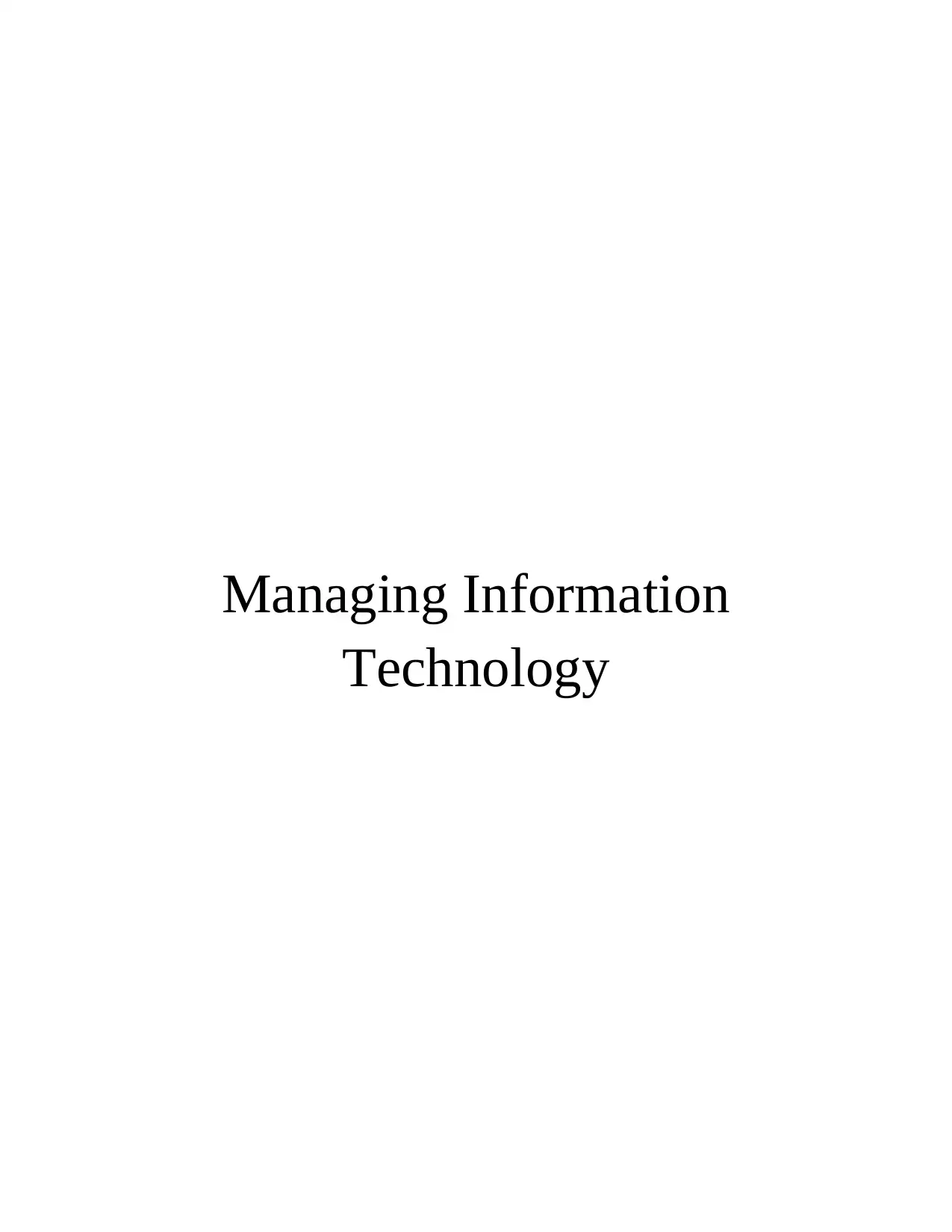
Managing Information
Technology
Technology
Paraphrase This Document
Need a fresh take? Get an instant paraphrase of this document with our AI Paraphraser
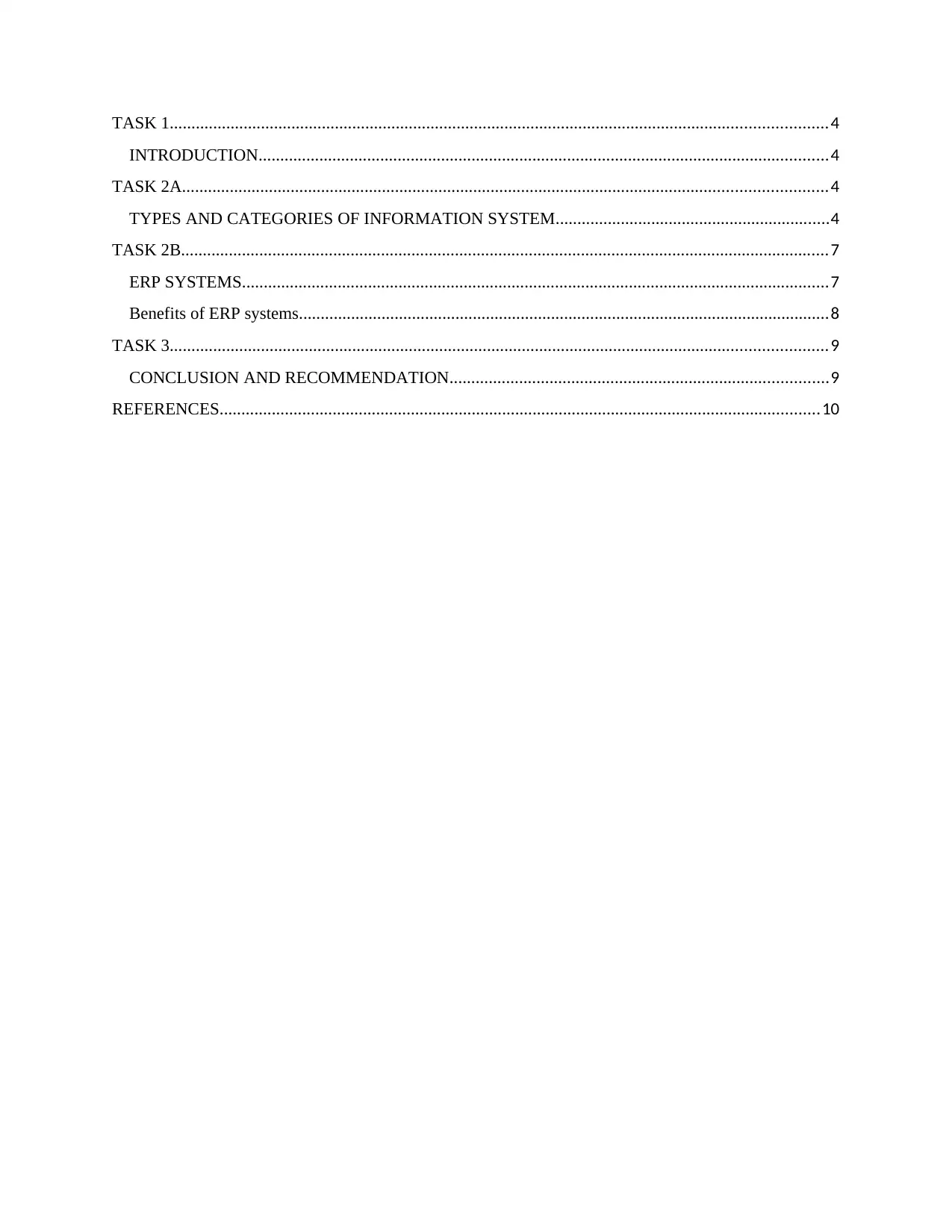
TASK 1.......................................................................................................................................................4
INTRODUCTION...................................................................................................................................4
TASK 2A....................................................................................................................................................4
TYPES AND CATEGORIES OF INFORMATION SYSTEM...............................................................4
TASK 2B.....................................................................................................................................................7
ERP SYSTEMS.......................................................................................................................................7
Benefits of ERP systems..........................................................................................................................8
TASK 3.......................................................................................................................................................9
CONCLUSION AND RECOMMENDATION.......................................................................................9
REFERENCES..........................................................................................................................................10
INTRODUCTION...................................................................................................................................4
TASK 2A....................................................................................................................................................4
TYPES AND CATEGORIES OF INFORMATION SYSTEM...............................................................4
TASK 2B.....................................................................................................................................................7
ERP SYSTEMS.......................................................................................................................................7
Benefits of ERP systems..........................................................................................................................8
TASK 3.......................................................................................................................................................9
CONCLUSION AND RECOMMENDATION.......................................................................................9
REFERENCES..........................................................................................................................................10
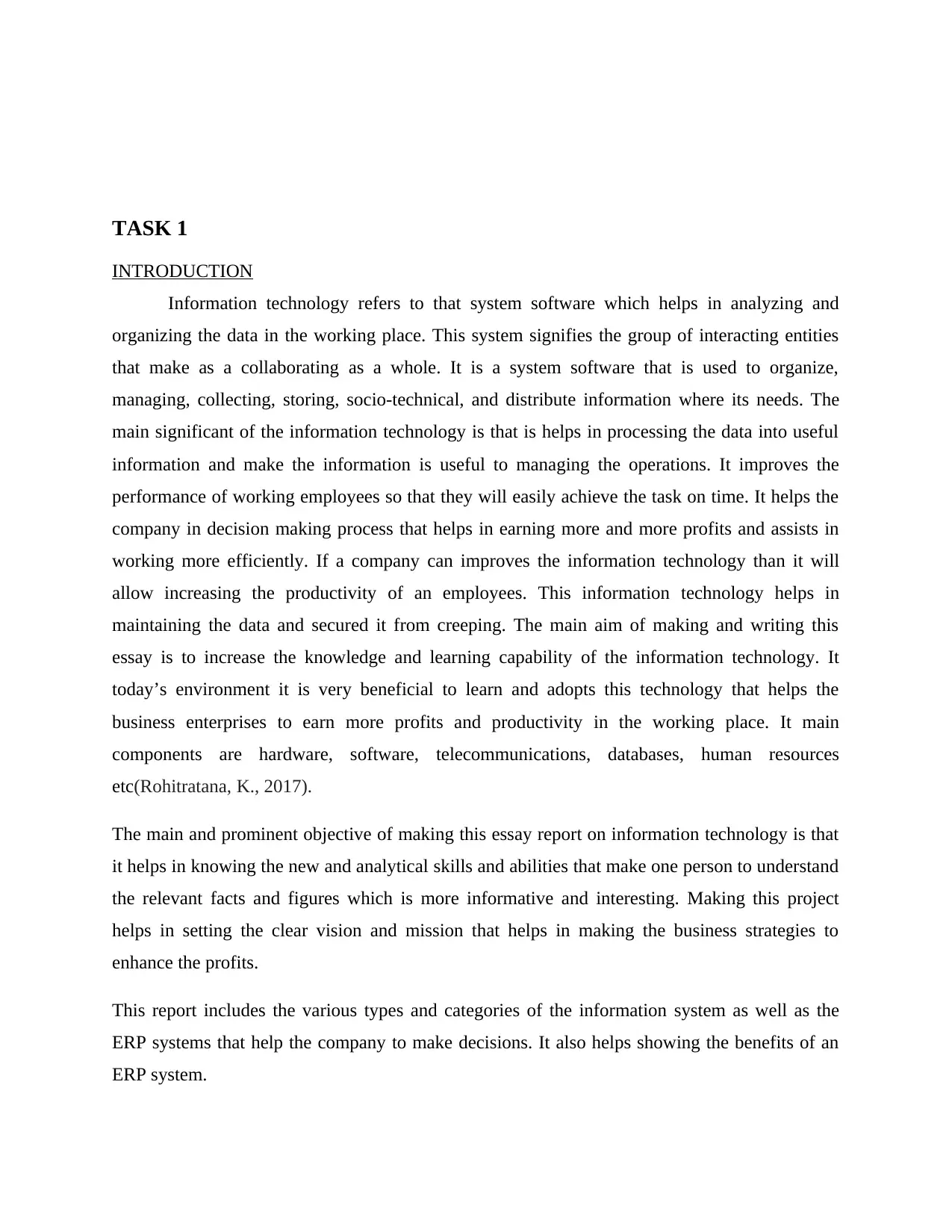
TASK 1
INTRODUCTION
Information technology refers to that system software which helps in analyzing and
organizing the data in the working place. This system signifies the group of interacting entities
that make as a collaborating as a whole. It is a system software that is used to organize,
managing, collecting, storing, socio-technical, and distribute information where its needs. The
main significant of the information technology is that is helps in processing the data into useful
information and make the information is useful to managing the operations. It improves the
performance of working employees so that they will easily achieve the task on time. It helps the
company in decision making process that helps in earning more and more profits and assists in
working more efficiently. If a company can improves the information technology than it will
allow increasing the productivity of an employees. This information technology helps in
maintaining the data and secured it from creeping. The main aim of making and writing this
essay is to increase the knowledge and learning capability of the information technology. It
today’s environment it is very beneficial to learn and adopts this technology that helps the
business enterprises to earn more profits and productivity in the working place. It main
components are hardware, software, telecommunications, databases, human resources
etc(Rohitratana, K., 2017).
The main and prominent objective of making this essay report on information technology is that
it helps in knowing the new and analytical skills and abilities that make one person to understand
the relevant facts and figures which is more informative and interesting. Making this project
helps in setting the clear vision and mission that helps in making the business strategies to
enhance the profits.
This report includes the various types and categories of the information system as well as the
ERP systems that help the company to make decisions. It also helps showing the benefits of an
ERP system.
INTRODUCTION
Information technology refers to that system software which helps in analyzing and
organizing the data in the working place. This system signifies the group of interacting entities
that make as a collaborating as a whole. It is a system software that is used to organize,
managing, collecting, storing, socio-technical, and distribute information where its needs. The
main significant of the information technology is that is helps in processing the data into useful
information and make the information is useful to managing the operations. It improves the
performance of working employees so that they will easily achieve the task on time. It helps the
company in decision making process that helps in earning more and more profits and assists in
working more efficiently. If a company can improves the information technology than it will
allow increasing the productivity of an employees. This information technology helps in
maintaining the data and secured it from creeping. The main aim of making and writing this
essay is to increase the knowledge and learning capability of the information technology. It
today’s environment it is very beneficial to learn and adopts this technology that helps the
business enterprises to earn more profits and productivity in the working place. It main
components are hardware, software, telecommunications, databases, human resources
etc(Rohitratana, K., 2017).
The main and prominent objective of making this essay report on information technology is that
it helps in knowing the new and analytical skills and abilities that make one person to understand
the relevant facts and figures which is more informative and interesting. Making this project
helps in setting the clear vision and mission that helps in making the business strategies to
enhance the profits.
This report includes the various types and categories of the information system as well as the
ERP systems that help the company to make decisions. It also helps showing the benefits of an
ERP system.
⊘ This is a preview!⊘
Do you want full access?
Subscribe today to unlock all pages.

Trusted by 1+ million students worldwide
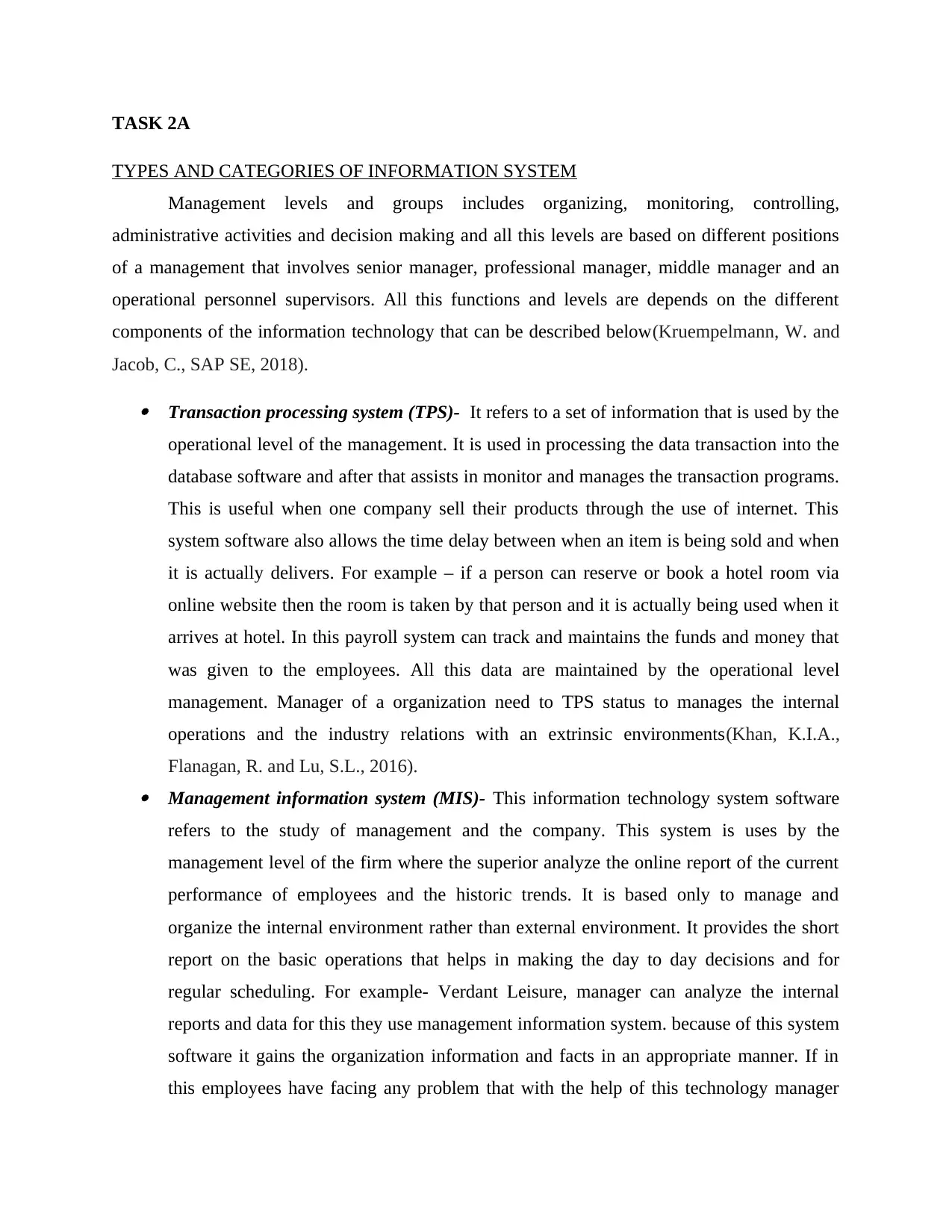
TASK 2A
TYPES AND CATEGORIES OF INFORMATION SYSTEM
Management levels and groups includes organizing, monitoring, controlling,
administrative activities and decision making and all this levels are based on different positions
of a management that involves senior manager, professional manager, middle manager and an
operational personnel supervisors. All this functions and levels are depends on the different
components of the information technology that can be described below(Kruempelmann, W. and
Jacob, C., SAP SE, 2018).
Transaction processing system (TPS)- It refers to a set of information that is used by the
operational level of the management. It is used in processing the data transaction into the
database software and after that assists in monitor and manages the transaction programs.
This is useful when one company sell their products through the use of internet. This
system software also allows the time delay between when an item is being sold and when
it is actually delivers. For example – if a person can reserve or book a hotel room via
online website then the room is taken by that person and it is actually being used when it
arrives at hotel. In this payroll system can track and maintains the funds and money that
was given to the employees. All this data are maintained by the operational level
management. Manager of a organization need to TPS status to manages the internal
operations and the industry relations with an extrinsic environments(Khan, K.I.A.,
Flanagan, R. and Lu, S.L., 2016). Management information system (MIS)- This information technology system software
refers to the study of management and the company. This system is uses by the
management level of the firm where the superior analyze the online report of the current
performance of employees and the historic trends. It is based only to manage and
organize the internal environment rather than external environment. It provides the short
report on the basic operations that helps in making the day to day decisions and for
regular scheduling. For example- Verdant Leisure, manager can analyze the internal
reports and data for this they use management information system. because of this system
software it gains the organization information and facts in an appropriate manner. If in
this employees have facing any problem that with the help of this technology manager
TYPES AND CATEGORIES OF INFORMATION SYSTEM
Management levels and groups includes organizing, monitoring, controlling,
administrative activities and decision making and all this levels are based on different positions
of a management that involves senior manager, professional manager, middle manager and an
operational personnel supervisors. All this functions and levels are depends on the different
components of the information technology that can be described below(Kruempelmann, W. and
Jacob, C., SAP SE, 2018).
Transaction processing system (TPS)- It refers to a set of information that is used by the
operational level of the management. It is used in processing the data transaction into the
database software and after that assists in monitor and manages the transaction programs.
This is useful when one company sell their products through the use of internet. This
system software also allows the time delay between when an item is being sold and when
it is actually delivers. For example – if a person can reserve or book a hotel room via
online website then the room is taken by that person and it is actually being used when it
arrives at hotel. In this payroll system can track and maintains the funds and money that
was given to the employees. All this data are maintained by the operational level
management. Manager of a organization need to TPS status to manages the internal
operations and the industry relations with an extrinsic environments(Khan, K.I.A.,
Flanagan, R. and Lu, S.L., 2016). Management information system (MIS)- This information technology system software
refers to the study of management and the company. This system is uses by the
management level of the firm where the superior analyze the online report of the current
performance of employees and the historic trends. It is based only to manage and
organize the internal environment rather than external environment. It provides the short
report on the basic operations that helps in making the day to day decisions and for
regular scheduling. For example- Verdant Leisure, manager can analyze the internal
reports and data for this they use management information system. because of this system
software it gains the organization information and facts in an appropriate manner. If in
this employees have facing any problem that with the help of this technology manager
Paraphrase This Document
Need a fresh take? Get an instant paraphrase of this document with our AI Paraphraser
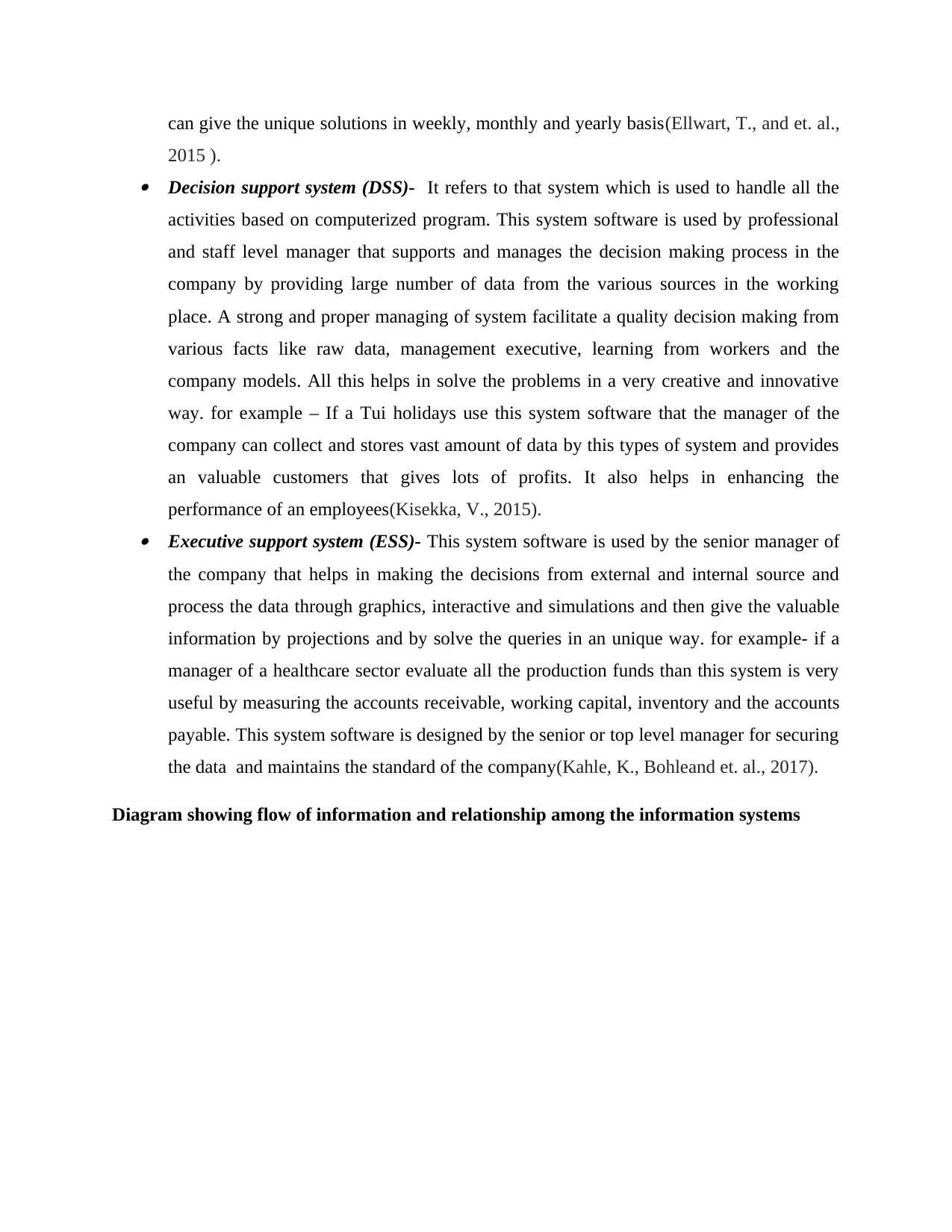
can give the unique solutions in weekly, monthly and yearly basis(Ellwart, T., and et. al.,
2015 ). Decision support system (DSS)- It refers to that system which is used to handle all the
activities based on computerized program. This system software is used by professional
and staff level manager that supports and manages the decision making process in the
company by providing large number of data from the various sources in the working
place. A strong and proper managing of system facilitate a quality decision making from
various facts like raw data, management executive, learning from workers and the
company models. All this helps in solve the problems in a very creative and innovative
way. for example – If a Tui holidays use this system software that the manager of the
company can collect and stores vast amount of data by this types of system and provides
an valuable customers that gives lots of profits. It also helps in enhancing the
performance of an employees(Kisekka, V., 2015). Executive support system (ESS)- This system software is used by the senior manager of
the company that helps in making the decisions from external and internal source and
process the data through graphics, interactive and simulations and then give the valuable
information by projections and by solve the queries in an unique way. for example- if a
manager of a healthcare sector evaluate all the production funds than this system is very
useful by measuring the accounts receivable, working capital, inventory and the accounts
payable. This system software is designed by the senior or top level manager for securing
the data and maintains the standard of the company(Kahle, K., Bohleand et. al., 2017).
Diagram showing flow of information and relationship among the information systems
2015 ). Decision support system (DSS)- It refers to that system which is used to handle all the
activities based on computerized program. This system software is used by professional
and staff level manager that supports and manages the decision making process in the
company by providing large number of data from the various sources in the working
place. A strong and proper managing of system facilitate a quality decision making from
various facts like raw data, management executive, learning from workers and the
company models. All this helps in solve the problems in a very creative and innovative
way. for example – If a Tui holidays use this system software that the manager of the
company can collect and stores vast amount of data by this types of system and provides
an valuable customers that gives lots of profits. It also helps in enhancing the
performance of an employees(Kisekka, V., 2015). Executive support system (ESS)- This system software is used by the senior manager of
the company that helps in making the decisions from external and internal source and
process the data through graphics, interactive and simulations and then give the valuable
information by projections and by solve the queries in an unique way. for example- if a
manager of a healthcare sector evaluate all the production funds than this system is very
useful by measuring the accounts receivable, working capital, inventory and the accounts
payable. This system software is designed by the senior or top level manager for securing
the data and maintains the standard of the company(Kahle, K., Bohleand et. al., 2017).
Diagram showing flow of information and relationship among the information systems
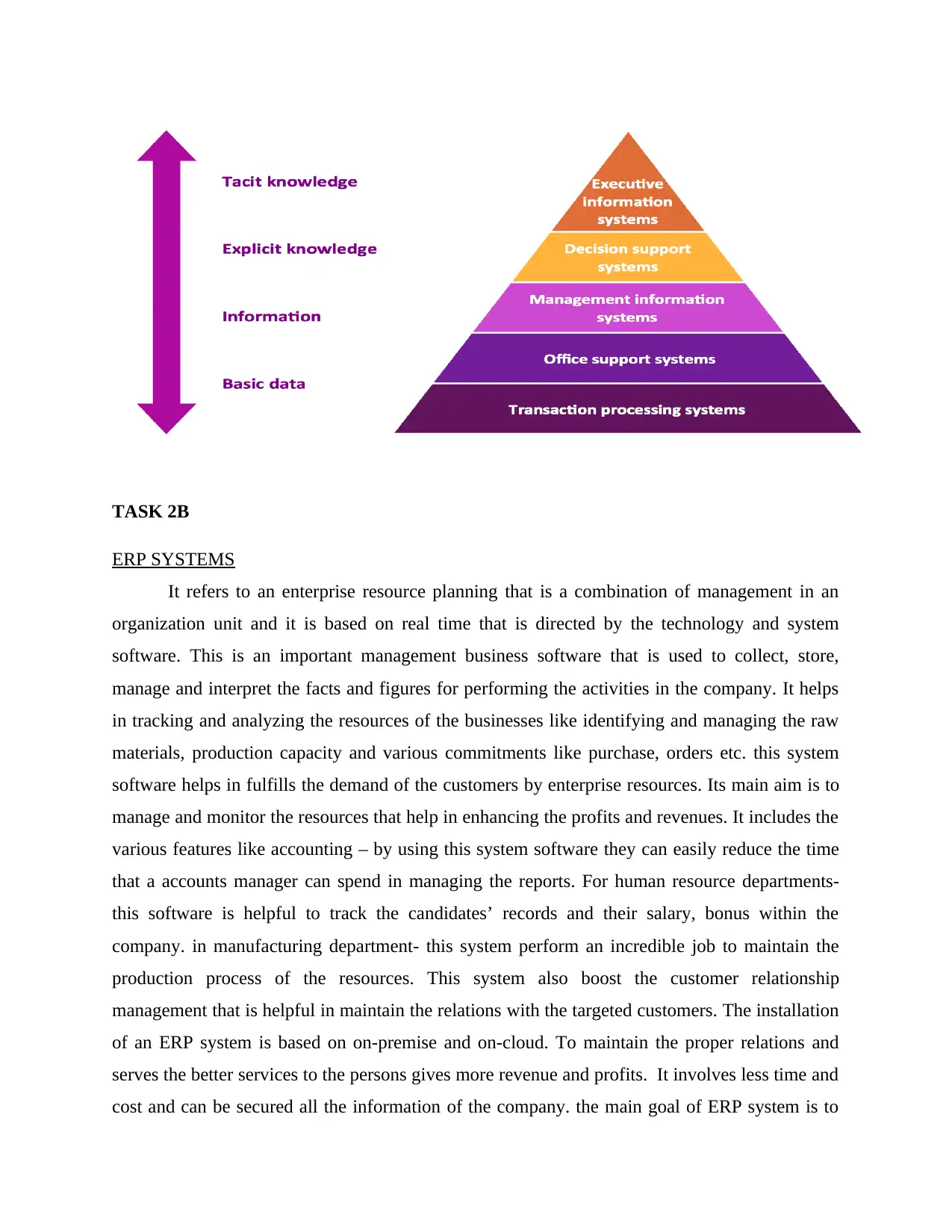
TASK 2B
ERP SYSTEMS
It refers to an enterprise resource planning that is a combination of management in an
organization unit and it is based on real time that is directed by the technology and system
software. This is an important management business software that is used to collect, store,
manage and interpret the facts and figures for performing the activities in the company. It helps
in tracking and analyzing the resources of the businesses like identifying and managing the raw
materials, production capacity and various commitments like purchase, orders etc. this system
software helps in fulfills the demand of the customers by enterprise resources. Its main aim is to
manage and monitor the resources that help in enhancing the profits and revenues. It includes the
various features like accounting – by using this system software they can easily reduce the time
that a accounts manager can spend in managing the reports. For human resource departments-
this software is helpful to track the candidates’ records and their salary, bonus within the
company. in manufacturing department- this system perform an incredible job to maintain the
production process of the resources. This system also boost the customer relationship
management that is helpful in maintain the relations with the targeted customers. The installation
of an ERP system is based on on-premise and on-cloud. To maintain the proper relations and
serves the better services to the persons gives more revenue and profits. It involves less time and
cost and can be secured all the information of the company. the main goal of ERP system is to
ERP SYSTEMS
It refers to an enterprise resource planning that is a combination of management in an
organization unit and it is based on real time that is directed by the technology and system
software. This is an important management business software that is used to collect, store,
manage and interpret the facts and figures for performing the activities in the company. It helps
in tracking and analyzing the resources of the businesses like identifying and managing the raw
materials, production capacity and various commitments like purchase, orders etc. this system
software helps in fulfills the demand of the customers by enterprise resources. Its main aim is to
manage and monitor the resources that help in enhancing the profits and revenues. It includes the
various features like accounting – by using this system software they can easily reduce the time
that a accounts manager can spend in managing the reports. For human resource departments-
this software is helpful to track the candidates’ records and their salary, bonus within the
company. in manufacturing department- this system perform an incredible job to maintain the
production process of the resources. This system also boost the customer relationship
management that is helpful in maintain the relations with the targeted customers. The installation
of an ERP system is based on on-premise and on-cloud. To maintain the proper relations and
serves the better services to the persons gives more revenue and profits. It involves less time and
cost and can be secured all the information of the company. the main goal of ERP system is to
⊘ This is a preview!⊘
Do you want full access?
Subscribe today to unlock all pages.

Trusted by 1+ million students worldwide
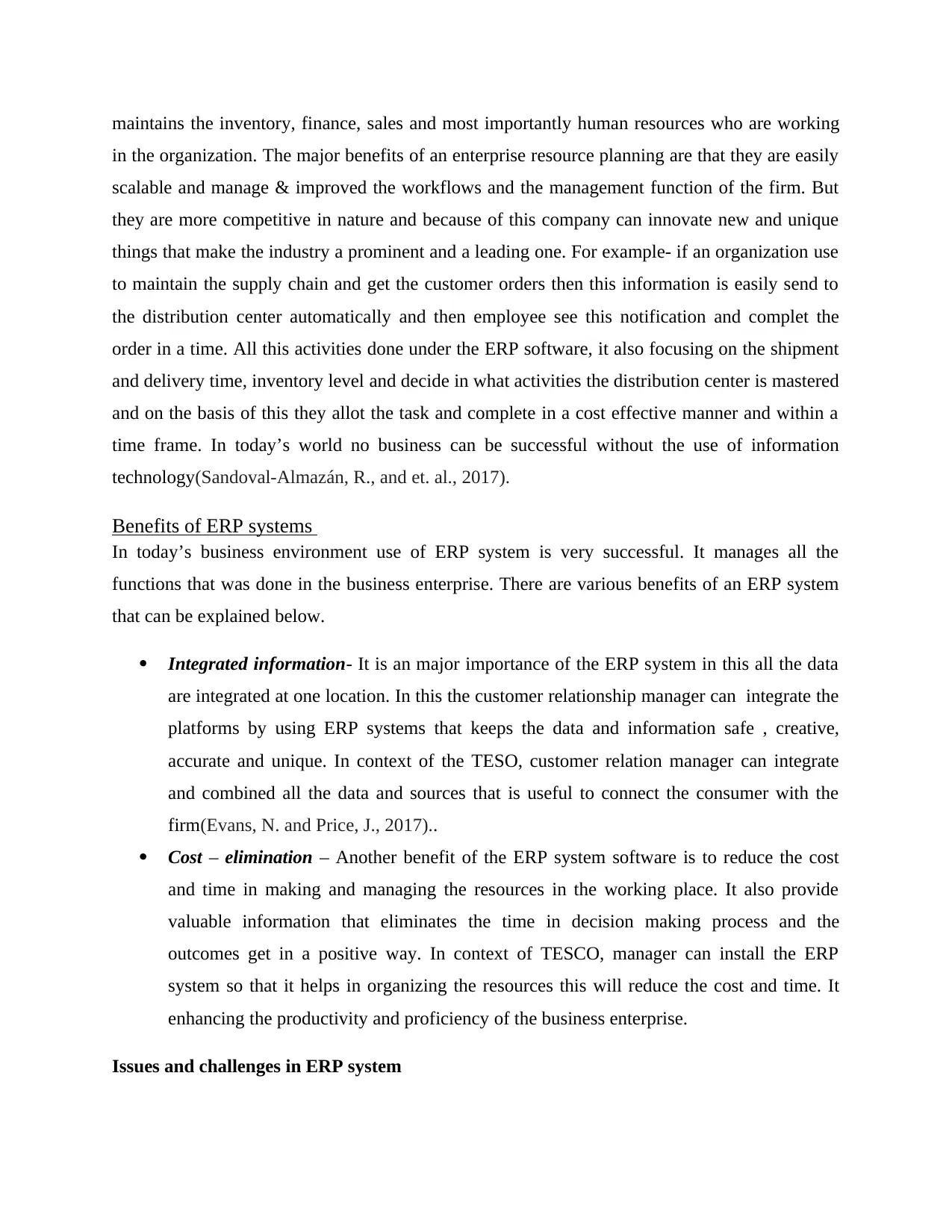
maintains the inventory, finance, sales and most importantly human resources who are working
in the organization. The major benefits of an enterprise resource planning are that they are easily
scalable and manage & improved the workflows and the management function of the firm. But
they are more competitive in nature and because of this company can innovate new and unique
things that make the industry a prominent and a leading one. For example- if an organization use
to maintain the supply chain and get the customer orders then this information is easily send to
the distribution center automatically and then employee see this notification and complet the
order in a time. All this activities done under the ERP software, it also focusing on the shipment
and delivery time, inventory level and decide in what activities the distribution center is mastered
and on the basis of this they allot the task and complete in a cost effective manner and within a
time frame. In today’s world no business can be successful without the use of information
technology(Sandoval-Almazán, R., and et. al., 2017).
Benefits of ERP systems
In today’s business environment use of ERP system is very successful. It manages all the
functions that was done in the business enterprise. There are various benefits of an ERP system
that can be explained below.
Integrated information- It is an major importance of the ERP system in this all the data
are integrated at one location. In this the customer relationship manager can integrate the
platforms by using ERP systems that keeps the data and information safe , creative,
accurate and unique. In context of the TESO, customer relation manager can integrate
and combined all the data and sources that is useful to connect the consumer with the
firm(Evans, N. and Price, J., 2017)..
Cost – elimination – Another benefit of the ERP system software is to reduce the cost
and time in making and managing the resources in the working place. It also provide
valuable information that eliminates the time in decision making process and the
outcomes get in a positive way. In context of TESCO, manager can install the ERP
system so that it helps in organizing the resources this will reduce the cost and time. It
enhancing the productivity and proficiency of the business enterprise.
Issues and challenges in ERP system
in the organization. The major benefits of an enterprise resource planning are that they are easily
scalable and manage & improved the workflows and the management function of the firm. But
they are more competitive in nature and because of this company can innovate new and unique
things that make the industry a prominent and a leading one. For example- if an organization use
to maintain the supply chain and get the customer orders then this information is easily send to
the distribution center automatically and then employee see this notification and complet the
order in a time. All this activities done under the ERP software, it also focusing on the shipment
and delivery time, inventory level and decide in what activities the distribution center is mastered
and on the basis of this they allot the task and complete in a cost effective manner and within a
time frame. In today’s world no business can be successful without the use of information
technology(Sandoval-Almazán, R., and et. al., 2017).
Benefits of ERP systems
In today’s business environment use of ERP system is very successful. It manages all the
functions that was done in the business enterprise. There are various benefits of an ERP system
that can be explained below.
Integrated information- It is an major importance of the ERP system in this all the data
are integrated at one location. In this the customer relationship manager can integrate the
platforms by using ERP systems that keeps the data and information safe , creative,
accurate and unique. In context of the TESO, customer relation manager can integrate
and combined all the data and sources that is useful to connect the consumer with the
firm(Evans, N. and Price, J., 2017)..
Cost – elimination – Another benefit of the ERP system software is to reduce the cost
and time in making and managing the resources in the working place. It also provide
valuable information that eliminates the time in decision making process and the
outcomes get in a positive way. In context of TESCO, manager can install the ERP
system so that it helps in organizing the resources this will reduce the cost and time. It
enhancing the productivity and proficiency of the business enterprise.
Issues and challenges in ERP system
Paraphrase This Document
Need a fresh take? Get an instant paraphrase of this document with our AI Paraphraser
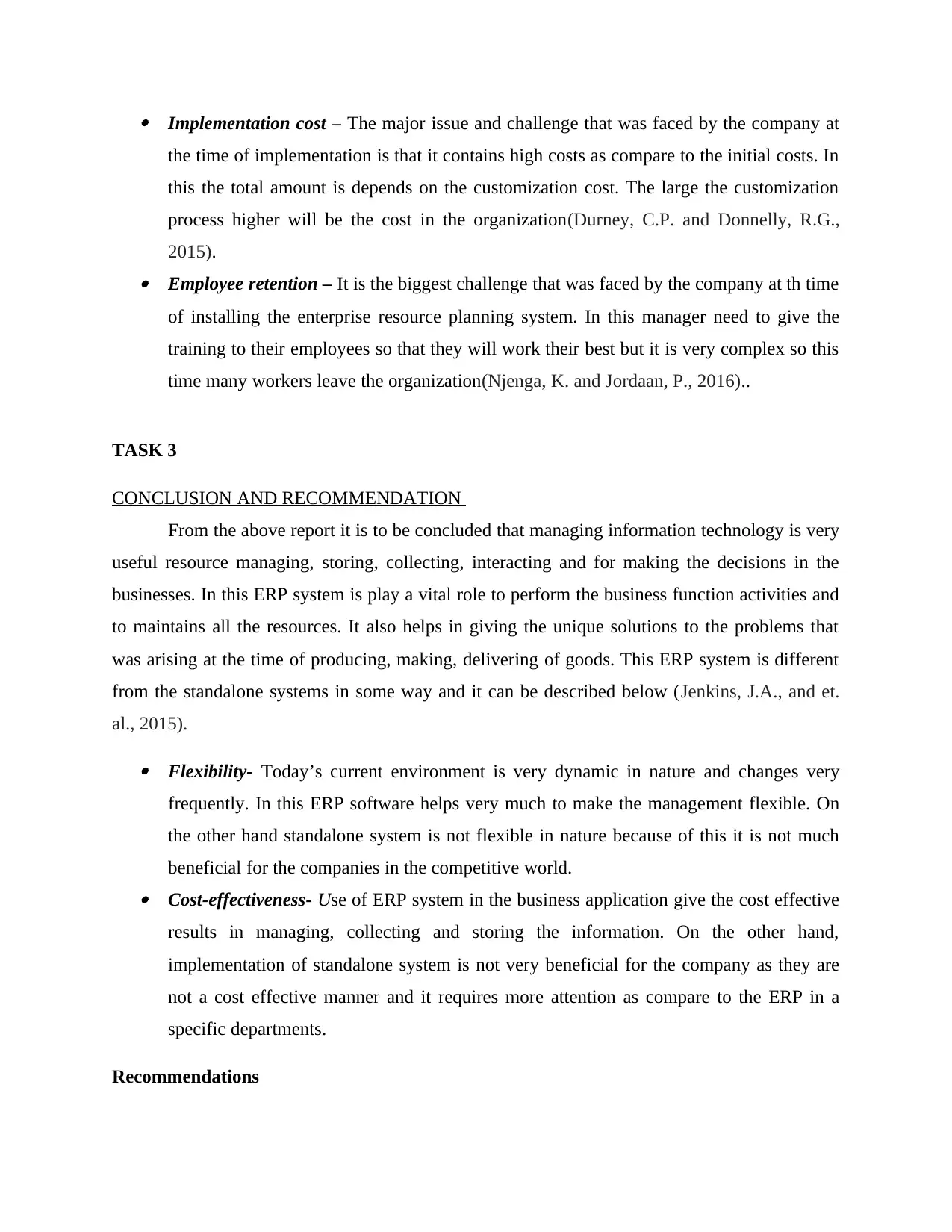
Implementation cost – The major issue and challenge that was faced by the company at
the time of implementation is that it contains high costs as compare to the initial costs. In
this the total amount is depends on the customization cost. The large the customization
process higher will be the cost in the organization(Durney, C.P. and Donnelly, R.G.,
2015). Employee retention – It is the biggest challenge that was faced by the company at th time
of installing the enterprise resource planning system. In this manager need to give the
training to their employees so that they will work their best but it is very complex so this
time many workers leave the organization(Njenga, K. and Jordaan, P., 2016)..
TASK 3
CONCLUSION AND RECOMMENDATION
From the above report it is to be concluded that managing information technology is very
useful resource managing, storing, collecting, interacting and for making the decisions in the
businesses. In this ERP system is play a vital role to perform the business function activities and
to maintains all the resources. It also helps in giving the unique solutions to the problems that
was arising at the time of producing, making, delivering of goods. This ERP system is different
from the standalone systems in some way and it can be described below (Jenkins, J.A., and et.
al., 2015).
Flexibility- Today’s current environment is very dynamic in nature and changes very
frequently. In this ERP software helps very much to make the management flexible. On
the other hand standalone system is not flexible in nature because of this it is not much
beneficial for the companies in the competitive world. Cost-effectiveness- Use of ERP system in the business application give the cost effective
results in managing, collecting and storing the information. On the other hand,
implementation of standalone system is not very beneficial for the company as they are
not a cost effective manner and it requires more attention as compare to the ERP in a
specific departments.
Recommendations
the time of implementation is that it contains high costs as compare to the initial costs. In
this the total amount is depends on the customization cost. The large the customization
process higher will be the cost in the organization(Durney, C.P. and Donnelly, R.G.,
2015). Employee retention – It is the biggest challenge that was faced by the company at th time
of installing the enterprise resource planning system. In this manager need to give the
training to their employees so that they will work their best but it is very complex so this
time many workers leave the organization(Njenga, K. and Jordaan, P., 2016)..
TASK 3
CONCLUSION AND RECOMMENDATION
From the above report it is to be concluded that managing information technology is very
useful resource managing, storing, collecting, interacting and for making the decisions in the
businesses. In this ERP system is play a vital role to perform the business function activities and
to maintains all the resources. It also helps in giving the unique solutions to the problems that
was arising at the time of producing, making, delivering of goods. This ERP system is different
from the standalone systems in some way and it can be described below (Jenkins, J.A., and et.
al., 2015).
Flexibility- Today’s current environment is very dynamic in nature and changes very
frequently. In this ERP software helps very much to make the management flexible. On
the other hand standalone system is not flexible in nature because of this it is not much
beneficial for the companies in the competitive world. Cost-effectiveness- Use of ERP system in the business application give the cost effective
results in managing, collecting and storing the information. On the other hand,
implementation of standalone system is not very beneficial for the company as they are
not a cost effective manner and it requires more attention as compare to the ERP in a
specific departments.
Recommendations
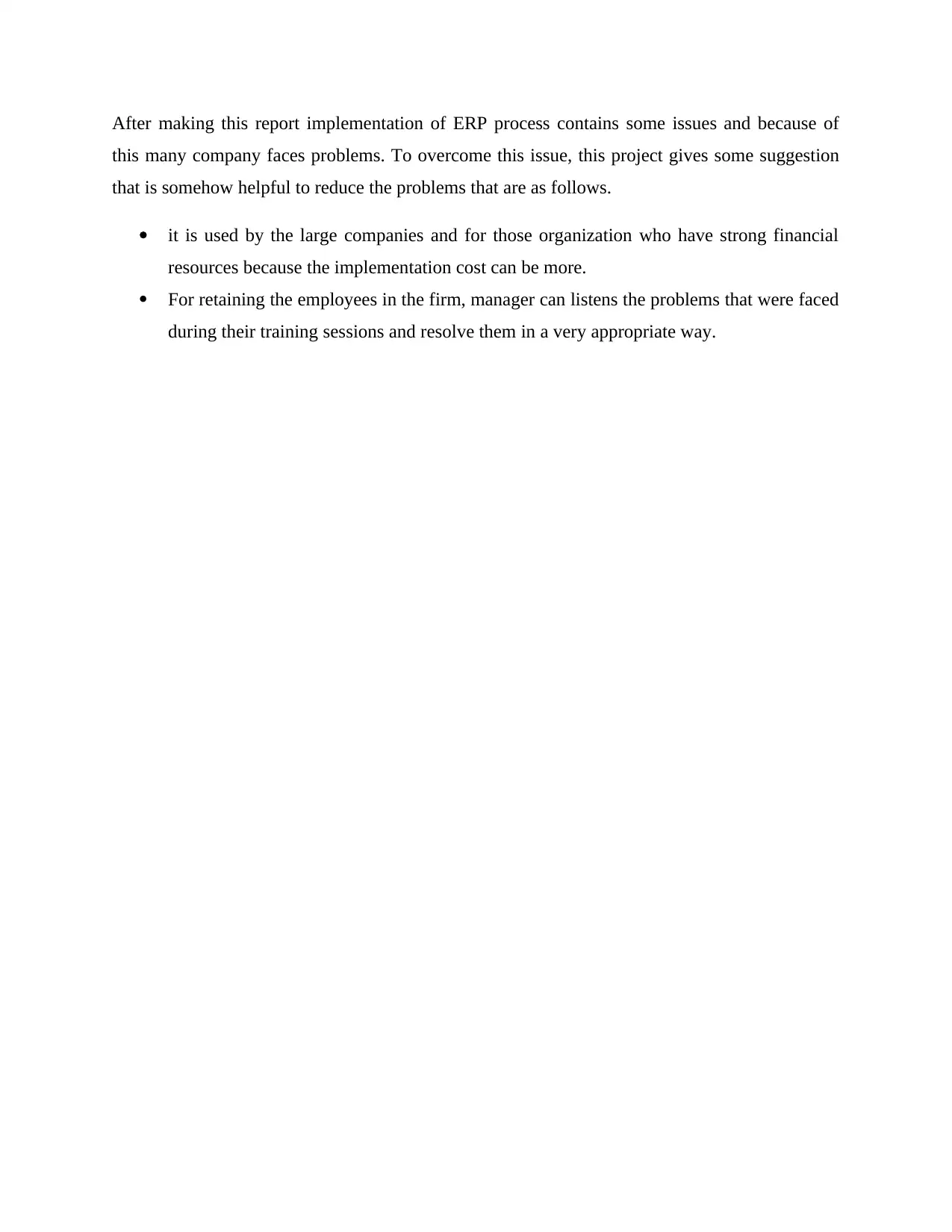
After making this report implementation of ERP process contains some issues and because of
this many company faces problems. To overcome this issue, this project gives some suggestion
that is somehow helpful to reduce the problems that are as follows.
it is used by the large companies and for those organization who have strong financial
resources because the implementation cost can be more.
For retaining the employees in the firm, manager can listens the problems that were faced
during their training sessions and resolve them in a very appropriate way.
this many company faces problems. To overcome this issue, this project gives some suggestion
that is somehow helpful to reduce the problems that are as follows.
it is used by the large companies and for those organization who have strong financial
resources because the implementation cost can be more.
For retaining the employees in the firm, manager can listens the problems that were faced
during their training sessions and resolve them in a very appropriate way.
⊘ This is a preview!⊘
Do you want full access?
Subscribe today to unlock all pages.

Trusted by 1+ million students worldwide
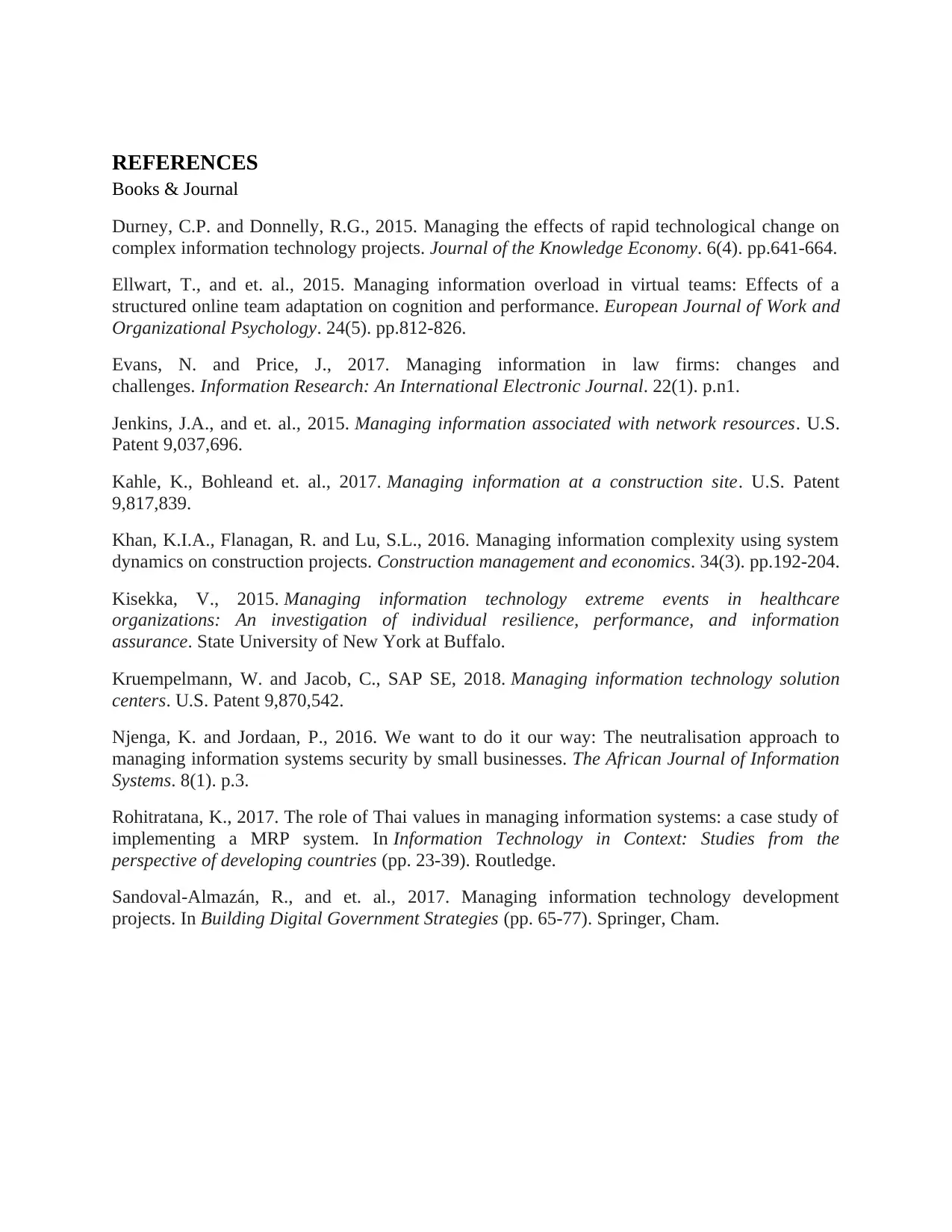
REFERENCES
Books & Journal
Durney, C.P. and Donnelly, R.G., 2015. Managing the effects of rapid technological change on
complex information technology projects. Journal of the Knowledge Economy. 6(4). pp.641-664.
Ellwart, T., and et. al., 2015. Managing information overload in virtual teams: Effects of a
structured online team adaptation on cognition and performance. European Journal of Work and
Organizational Psychology. 24(5). pp.812-826.
Evans, N. and Price, J., 2017. Managing information in law firms: changes and
challenges. Information Research: An International Electronic Journal. 22(1). p.n1.
Jenkins, J.A., and et. al., 2015. Managing information associated with network resources. U.S.
Patent 9,037,696.
Kahle, K., Bohleand et. al., 2017. Managing information at a construction site. U.S. Patent
9,817,839.
Khan, K.I.A., Flanagan, R. and Lu, S.L., 2016. Managing information complexity using system
dynamics on construction projects. Construction management and economics. 34(3). pp.192-204.
Kisekka, V., 2015. Managing information technology extreme events in healthcare
organizations: An investigation of individual resilience, performance, and information
assurance. State University of New York at Buffalo.
Kruempelmann, W. and Jacob, C., SAP SE, 2018. Managing information technology solution
centers. U.S. Patent 9,870,542.
Njenga, K. and Jordaan, P., 2016. We want to do it our way: The neutralisation approach to
managing information systems security by small businesses. The African Journal of Information
Systems. 8(1). p.3.
Rohitratana, K., 2017. The role of Thai values in managing information systems: a case study of
implementing a MRP system. In Information Technology in Context: Studies from the
perspective of developing countries (pp. 23-39). Routledge.
Sandoval-Almazán, R., and et. al., 2017. Managing information technology development
projects. In Building Digital Government Strategies (pp. 65-77). Springer, Cham.
Books & Journal
Durney, C.P. and Donnelly, R.G., 2015. Managing the effects of rapid technological change on
complex information technology projects. Journal of the Knowledge Economy. 6(4). pp.641-664.
Ellwart, T., and et. al., 2015. Managing information overload in virtual teams: Effects of a
structured online team adaptation on cognition and performance. European Journal of Work and
Organizational Psychology. 24(5). pp.812-826.
Evans, N. and Price, J., 2017. Managing information in law firms: changes and
challenges. Information Research: An International Electronic Journal. 22(1). p.n1.
Jenkins, J.A., and et. al., 2015. Managing information associated with network resources. U.S.
Patent 9,037,696.
Kahle, K., Bohleand et. al., 2017. Managing information at a construction site. U.S. Patent
9,817,839.
Khan, K.I.A., Flanagan, R. and Lu, S.L., 2016. Managing information complexity using system
dynamics on construction projects. Construction management and economics. 34(3). pp.192-204.
Kisekka, V., 2015. Managing information technology extreme events in healthcare
organizations: An investigation of individual resilience, performance, and information
assurance. State University of New York at Buffalo.
Kruempelmann, W. and Jacob, C., SAP SE, 2018. Managing information technology solution
centers. U.S. Patent 9,870,542.
Njenga, K. and Jordaan, P., 2016. We want to do it our way: The neutralisation approach to
managing information systems security by small businesses. The African Journal of Information
Systems. 8(1). p.3.
Rohitratana, K., 2017. The role of Thai values in managing information systems: a case study of
implementing a MRP system. In Information Technology in Context: Studies from the
perspective of developing countries (pp. 23-39). Routledge.
Sandoval-Almazán, R., and et. al., 2017. Managing information technology development
projects. In Building Digital Government Strategies (pp. 65-77). Springer, Cham.
Paraphrase This Document
Need a fresh take? Get an instant paraphrase of this document with our AI Paraphraser

1 out of 11
Related Documents
Your All-in-One AI-Powered Toolkit for Academic Success.
+13062052269
info@desklib.com
Available 24*7 on WhatsApp / Email
![[object Object]](/_next/static/media/star-bottom.7253800d.svg)
Unlock your academic potential
Copyright © 2020–2025 A2Z Services. All Rights Reserved. Developed and managed by ZUCOL.




